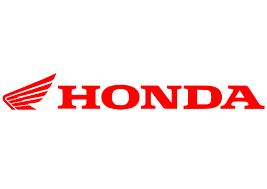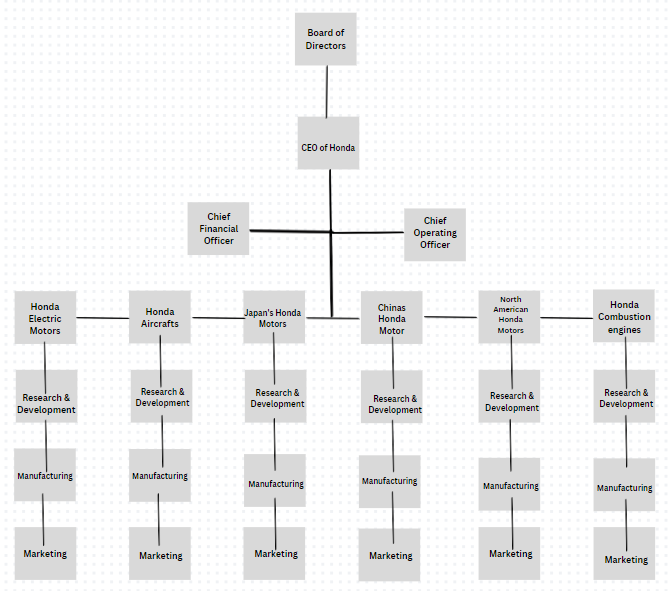
March 18, 2023
Honda is a Japanese company that produces cars, motorcycles, and power equipment. Its headquarters are in Tokyo, Japan, and has been the largest motorcycle producer in the world since 1959. Additionally, Honda produces more than 14 million internal combustion engines annually, making it the largest producer in the world. This ranks Honda as the eighth-largest automaker worldwide in 2015. Although I have no direct relationship with the company I chose Honda because they are my favorite car brand and a technology leader in the industry. Honda’s mission statement is “supplying products of the highest quality, yet at a reasonable price for worldwide customer satisfaction”.
Honda has undergone significant adjustments recently in order to meet its 2030 global vision. As the automotive industry enters a period of significant change, Honda’s vision for 2030 is to “keep being a business that meets and exceeds its customers’ expectations”. With this said, early in 2020, the firm undertook significant modifications to its organizational and operational structures in order to make progress toward its 2030 global vision targets. Honda changed from a collaborative structure where each division had full autonomy to one that was more cohesive and unified.
Below we will Analyze the organization’s external environmental factors and explain which ones are currently having the biggest impact.
Political: These impacts come from policies and regulations from governments around the world. Although there aren’t many positive political impacts, India’s reduction in corporate taxes and the upcoming development in African countries directly benefit Honda. Some political impacts that are negative include the changing tariffs on imports and exports between China and the US. Secondly, some governments across the world disagree with the use of individual vehicles through certain policies. And Lastly, the US and Canada’s gas-powered car sales ban will take place in 2030 and will affect all car manufacturers forcing them to invest more in electric research and development.
Economic: Some economic factors that could have a great impact on Honda include India’s slow rise in income over the past years. Honda should control the pricing of the existing vehicles being sold there but also sell more 2-wheel products because India has a huge market for this. Other impacts include BREXIT which is affecting the currency exchange rates which affect the profitability Honda will have within those countries. Lastly, with the increased prices in fuel, Honda needs to combat this by changing their strategies towards fuel efficiency, hybrid cars, or fully electric cars.
Social: Some social factors Honda can take advantage of is promoting their range of cars in Saudi Arabia. With new laws allowing women to drive, there is a gap in the market that they can fill. Additionally, Honda can notice countries that have high populations driving 2-wheel motor vehicles, and who are environmentally conscious because they may have an interest in electric scooters which Honda can provide
Technological: These factors can have a big impact on the company, including an example in India where Honda launched their new scooter which has new leading technology and is fulfilling the needs of India’s market.
Environmental: These factors may be obvious but include, the new trend of reducing carbon emissions and transforming Honda’s fleet into all-electric. Lastly, I think the biggest environmental issue is the current depletion of materials and the uncertain depletion of resources which will take place when we switch to electric vehicles.
Legal: Other than environmental legal factors which can greatly affect the profitability of Honda. Other factors like the quality of products can have huge effects on the company too. An example of this can be taken from India where Honda had to recall 50,000 2-wheel vehicles because of their faulty brake issues.
To examine the organization’s internal environment, we will use the first half of a SWOT analysis to uncover the strengths and weaknesses and explain what factors would have the biggest impact on the organizational structure.
Strengths: A strength of Honda is its future vision and creation of new technologically innovative products, this will broaden the organizational structure and bring new departments into its organization. Additionally, Honda has a broad range of products, but with this comes different department heads for each division like motorcycles, power equipment, private jets, engines, and cars. If Honda wants to be successful within their huge range of products their organizational structure must be cohesive and work as one towards a common goal.
Weaknesses: A weakness of Honda is its need for Higher Investment in research and development. Although Honda used to be a technological leader in combustion engine cars, Honda needs to make a larger investment in the new technology sector of battery electric cars. This will require the organization to come up with new products and ideas and will need to be properly managed within the organizational structure.
In regard to Honda’s organizational structure, I think the recent move Honda made in 2020 from a decentralized organizational structure towards a more centralized, top-down structure was a great decision. With the world being everchanging and new trends coming out every month there’s so much for an organization to account for. With a centralized organizational structure, the company can avoid confusion by being unified and sticking towards a common goal to function more efficiently, and effectively. Additionally, in such a fast-paced world we need fast-paced decisions. With this style of organizational structure, the decision-making process occurs at one level of management, meaning decisions can be finalized, distributed, and implemented much faster than decisions that require input from multiple boards, department heads, and groups of people. The recent changes made to the organizational structure need time to prove themselves effective, which is why I wouldn’t change anything towards the organizational structure at this point.

References:
A. (2023, January 21). Honda SWOT Analysis 2023: A Fast-Paced Report! |. Ronique &Amp; Co LLC. https://swothub.com/honda-swot-analysis/
Momin, A. (2023, January 17). Honda SWOT Analysis 2023: What Makes Honda Special? PESTLE Analysis. https://pestleanalysis.com/honda-swot-analysis/
Organimi. (2021, October 26). Honda Organizational Structure [Interactive Chart] | Organimi. https://www.organimi.com/organizational-structures/honda/
Team, M. S. (2019, October 29). Honda PESTLE Analysis. MBA Skool. https://www.mbaskool.com/pestle-analysis/companies/17980-honda.html
Shastri, A. (2022, October 28). Detailed SWOT Analysis of Honda – 2023 Updated | IIDE. IIDE. https://iide.co/case-studies/swot-analysis-of-honda/
Leave a comment